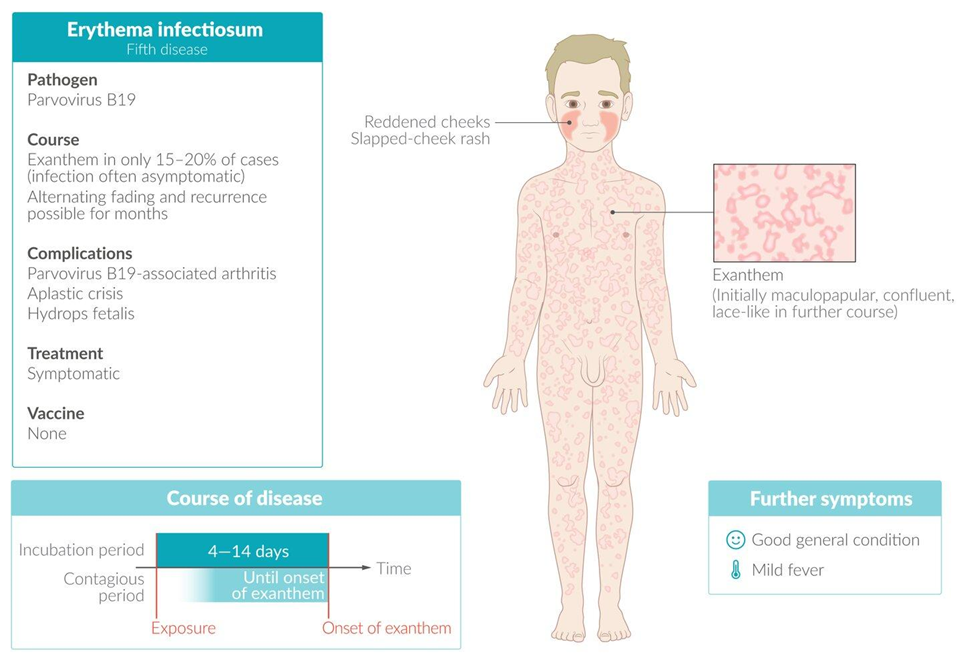On assessment, the school nurse notes that the child has a rash. The nurse suspects that the child has erythema infectiosum (fifth disease). because the skin assessment revealed a rash that has which characteristics?
A highly pruritic profuse macule to papule rash on the trunk
A discrete pinkish red maculopapular rash that is spreading to the trunk
An erythema on the face that has a "slapped face appearance
A discrete rose-pink maculopapular rash on the trunk
The Correct Answer is C
A. A highly pruritic profuse macule to papule rash on the trunk
Explanation: This description does not fit the typical characteristics of erythema infectiosum. Fifth disease is not typically associated with a highly pruritic rash.
B. A discrete pinkish red maculopapular rash that is spreading to the trunk
Explanation: While erythema infectiosum does involve a rash that can spread to the trunk, the distinctive "slapped face" appearance is a key characteristic that is not captured in this option.
C. An erythema on the face that has a "slapped face" appearance.
Explanation:
Erythema infectiosum, commonly known as fifth disease or slapped cheek syndrome, is characterized by a distinctive facial rash that gives the appearance of a "slapped face." The rash typically starts on the face and then spreads to the trunk and extremities. It often begins with erythema on the cheeks, giving the child a flushed or slapped appearance, followed by a discrete rose-pink maculopapular rash on the trunk.
D. A discrete rose-pink maculopapular rash on the trunk
Explanation: This description fits the typical characteristics of the rash seen in erythema infectiosum, but the key identifier is the "slapped face" appearance on the face.

Nursing Test Bank
Naxlex Comprehensive Predictor Exams
Related Questions
Correct Answer is ["A","B","C","D"]
Explanation
A. The child needs to avoid exposure to other illnesses.
Explanation: Children with AIDS have compromised immune systems and are more susceptible to infections. Therefore, it is important to minimize exposure to other illnesses to reduce the risk of infections.
B. Frequent handwashing is important.
Explanation: Good hand hygiene helps prevent the spread of infections. Encouraging frequent handwashing is crucial in the care of a child with AIDS.
C. Clean up body fluid spills with bleach solution (10:1 ratio of water to bleach).
Explanation: Using a bleach solution to clean up body fluid spills helps to disinfect and reduce the risk of transmission of infections. The recommended ratio is 10 parts water to 1 part bleach.
D. Monitor the child's weight.
Explanation: Monitoring the child's weight is important for assessing nutritional status and overall health. Weight loss may indicate underlying health issues that need attention.
E. The child's immunization schedule will need revision.
Explanation: Children with AIDS may have altered immune function, but the need for immunizations is still crucial. However, live vaccines may need to be avoided. The immunization schedule should be discussed and individualized with the healthcare provider.
F. Fever, malaise, fatigue, weight loss, vomiting, and diarrhea are expected to occur and do not require special intervention.
Explanation: While these symptoms may occur, they should not be dismissed without evaluation. Any changes in the child's health, including symptoms such as fever, malaise, fatigue, weight loss, vomiting, and diarrhea, should be reported to the healthcare provider for appropriate assessment and intervention.
Correct Answer is C
Explanation
A. Bottle-feed with diluted fruit juice:
Incorrect: Diluted fruit juice is not recommended for infants with diarrhea. Fruit juices, even when diluted, may contain sugars that can exacerbate diarrhea. It's important to focus on water or rehydration solutions.
B. Discontinue breast-feeding until the diarrhea resolves:
Incorrect: Breast milk is an essential source of nutrition for infants, and discontinuing breastfeeding is not recommended, even during episodes of mild diarrhea. Breast milk helps maintain hydration and provides essential nutrients.
C. Provide an increased intake of water.
Correct Answer: Maintaining hydration is crucial during episodes of diarrhea. Offering the infant increased water intake helps prevent dehydration. Rehydration solutions specifically designed for infants can also be recommended.
D. Avoid all solid foods:
Incorrect: While avoiding certain solid foods may be recommended in some cases, it's not necessary to completely avoid all solid foods for a 12-month-old with mild diarrhea. The emphasis should be on maintaining hydration and offering easily digestible foods.
Whether you are a student looking to ace your exams or a practicing nurse seeking to enhance your expertise , our nursing education contents will empower you with the confidence and competence to make a difference in the lives of patients and become a respected leader in the healthcare field.
Visit Naxlex, invest in your future and unlock endless possibilities with our unparalleled nursing education contents today
Report Wrong Answer on the Current Question
Do you disagree with the answer? If yes, what is your expected answer? Explain.
Kindly be descriptive with the issue you are facing.
